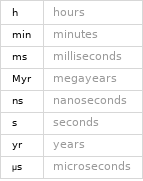Input interpretation

iodine (chemical element) | antimony (chemical element) | tin (chemical element)
Periodic table location
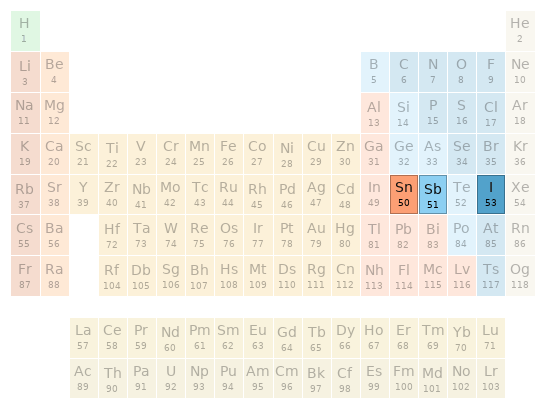
Periodic table location
Images
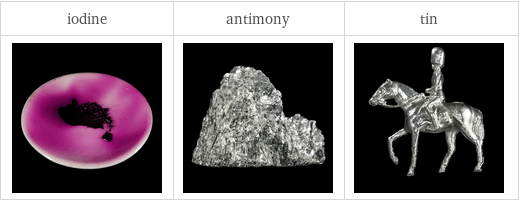
Images
Basic elemental properties
![| iodine | antimony | tin atomic symbol | I | Sb | Sn atomic number | 53 | 51 | 50 short electronic configuration | [Kr]5s^24d^105p^5 | [Kr]5s^24d^105p^3 | [Kr]5s^24d^105p^2 Aufbau diagram | 5p 4d 5s | 5p 4d 5s | 5p 4d 5s block | p | p | p group | 17 | 15 | 14 period | 5 | 5 | 5 atomic mass | 126.90447 u | 121.76 u | 118.71 u half-life | (stable) | (stable) | (stable)](../image_source/5e4f6ebaf3faea5f27b71cb6c2af39b9.png)
| iodine | antimony | tin atomic symbol | I | Sb | Sn atomic number | 53 | 51 | 50 short electronic configuration | [Kr]5s^24d^105p^5 | [Kr]5s^24d^105p^3 | [Kr]5s^24d^105p^2 Aufbau diagram | 5p 4d 5s | 5p 4d 5s | 5p 4d 5s block | p | p | p group | 17 | 15 | 14 period | 5 | 5 | 5 atomic mass | 126.90447 u | 121.76 u | 118.71 u half-life | (stable) | (stable) | (stable)
Thermodynamic properties
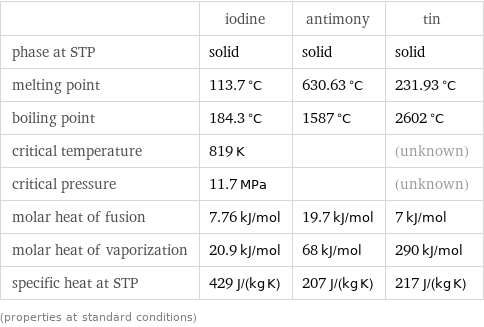
| iodine | antimony | tin phase at STP | solid | solid | solid melting point | 113.7 °C | 630.63 °C | 231.93 °C boiling point | 184.3 °C | 1587 °C | 2602 °C critical temperature | 819 K | | (unknown) critical pressure | 11.7 MPa | | (unknown) molar heat of fusion | 7.76 kJ/mol | 19.7 kJ/mol | 7 kJ/mol molar heat of vaporization | 20.9 kJ/mol | 68 kJ/mol | 290 kJ/mol specific heat at STP | 429 J/(kg K) | 207 J/(kg K) | 217 J/(kg K) (properties at standard conditions)
Material properties

| iodine | antimony | tin density | 4.94 g/cm^3 | 6.697 g/cm^3 | 7.31 g/cm^3 liquid density | | 6.53 g/cm^3 | 6.99 g/cm^3 molar volume | 25.69 cm^3/mol | 18.18 cm^3/mol | 16.24 cm^3/mol Mohs hardness | | 3 (≈ calcite) | 1.5 (between talc and gypsum) Brinell hardness | | 294 MPa | 51 MPa bulk modulus | 7.7 GPa | 42 GPa | 58 GPa shear modulus | | 20 GPa | 18 GPa Young's modulus | | 55 GPa | 50 GPa Poisson ratio | | | 0.36 ultimate tensile strength | | 11 MPa | 220 MPa sound speed | | 3420 m/s | 2500 m/s thermal expansion | | 1.1×10^-5 K^(-1) | 2.2×10^-5 K^(-1) thermal conductivity | 0.449 W/(m K) | 24 W/(m K) | 67 W/(m K) (properties at standard conditions)
Electromagnetic properties
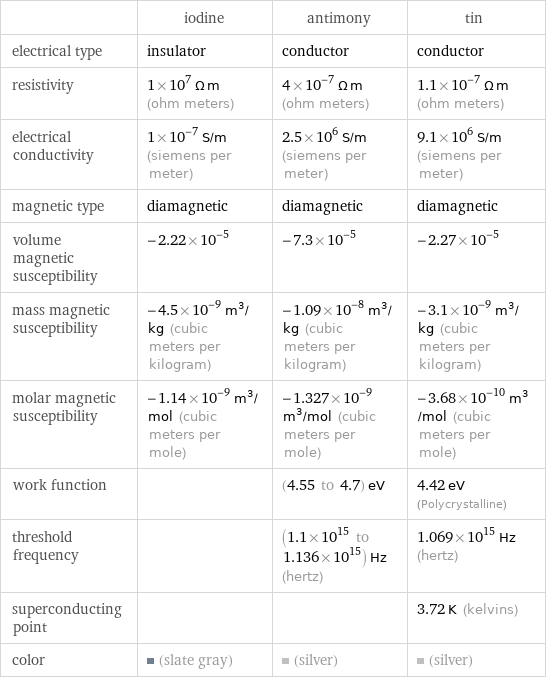
| iodine | antimony | tin electrical type | insulator | conductor | conductor resistivity | 1×10^7 Ω m (ohm meters) | 4×10^-7 Ω m (ohm meters) | 1.1×10^-7 Ω m (ohm meters) electrical conductivity | 1×10^-7 S/m (siemens per meter) | 2.5×10^6 S/m (siemens per meter) | 9.1×10^6 S/m (siemens per meter) magnetic type | diamagnetic | diamagnetic | diamagnetic volume magnetic susceptibility | -2.22×10^-5 | -7.3×10^-5 | -2.27×10^-5 mass magnetic susceptibility | -4.5×10^-9 m^3/kg (cubic meters per kilogram) | -1.09×10^-8 m^3/kg (cubic meters per kilogram) | -3.1×10^-9 m^3/kg (cubic meters per kilogram) molar magnetic susceptibility | -1.14×10^-9 m^3/mol (cubic meters per mole) | -1.327×10^-9 m^3/mol (cubic meters per mole) | -3.68×10^-10 m^3/mol (cubic meters per mole) work function | | (4.55 to 4.7) eV | 4.42 eV (Polycrystalline) threshold frequency | | (1.1×10^15 to 1.136×10^15) Hz (hertz) | 1.069×10^15 Hz (hertz) superconducting point | | | 3.72 K (kelvins) color | (slate gray) | (silver) | (silver)
Reactivity
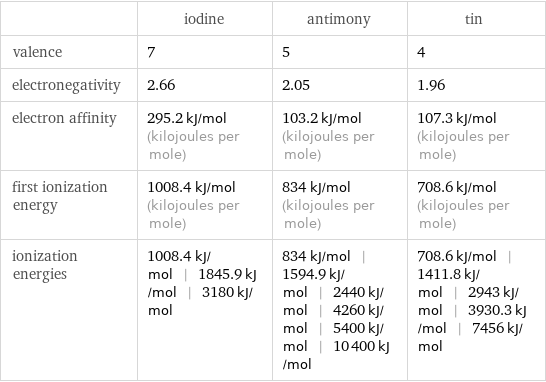
| iodine | antimony | tin valence | 7 | 5 | 4 electronegativity | 2.66 | 2.05 | 1.96 electron affinity | 295.2 kJ/mol (kilojoules per mole) | 103.2 kJ/mol (kilojoules per mole) | 107.3 kJ/mol (kilojoules per mole) first ionization energy | 1008.4 kJ/mol (kilojoules per mole) | 834 kJ/mol (kilojoules per mole) | 708.6 kJ/mol (kilojoules per mole) ionization energies | 1008.4 kJ/mol | 1845.9 kJ/mol | 3180 kJ/mol | 834 kJ/mol | 1594.9 kJ/mol | 2440 kJ/mol | 4260 kJ/mol | 5400 kJ/mol | 10400 kJ/mol | 708.6 kJ/mol | 1411.8 kJ/mol | 2943 kJ/mol | 3930.3 kJ/mol | 7456 kJ/mol

Reactivity
Atomic properties
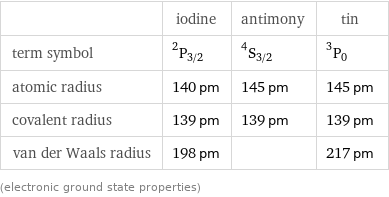
| iodine | antimony | tin term symbol | ^2P_(3/2) | ^4S_(3/2) | ^3P_0 atomic radius | 140 pm | 145 pm | 145 pm covalent radius | 139 pm | 139 pm | 139 pm van der Waals radius | 198 pm | | 217 pm (electronic ground state properties)
Abundances
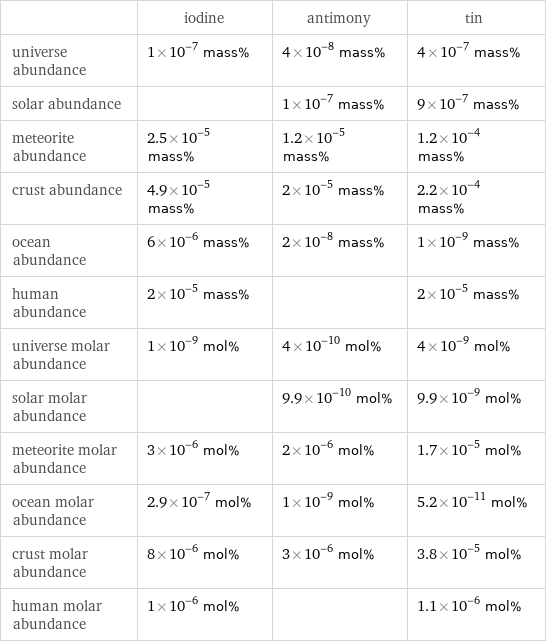
| iodine | antimony | tin universe abundance | 1×10^-7 mass% | 4×10^-8 mass% | 4×10^-7 mass% solar abundance | | 1×10^-7 mass% | 9×10^-7 mass% meteorite abundance | 2.5×10^-5 mass% | 1.2×10^-5 mass% | 1.2×10^-4 mass% crust abundance | 4.9×10^-5 mass% | 2×10^-5 mass% | 2.2×10^-4 mass% ocean abundance | 6×10^-6 mass% | 2×10^-8 mass% | 1×10^-9 mass% human abundance | 2×10^-5 mass% | | 2×10^-5 mass% universe molar abundance | 1×10^-9 mol% | 4×10^-10 mol% | 4×10^-9 mol% solar molar abundance | | 9.9×10^-10 mol% | 9.9×10^-9 mol% meteorite molar abundance | 3×10^-6 mol% | 2×10^-6 mol% | 1.7×10^-5 mol% ocean molar abundance | 2.9×10^-7 mol% | 1×10^-9 mol% | 5.2×10^-11 mol% crust molar abundance | 8×10^-6 mol% | 3×10^-6 mol% | 3.8×10^-5 mol% human molar abundance | 1×10^-6 mol% | | 1.1×10^-6 mol%
Nuclear properties

| iodine | antimony | tin half-life | (stable) | (stable) | (stable) stable isotopes | I-127 (100%) | Sb-121 (57.21%) | Sb-123 (42.79%) | Sn-120 (32.58%) | ... unstable isotopes | I-129 (15.7 Myr) | ... | Sb-125 (2.7586 yr) | ... | Sn-126 (0.23 Myr) | ...
Units
